Collection of materials relating to neuro-ophthalmology as part of the Neuro-Ophthalmology Virtual Education Library.
NOVEL: https://novel.utah.edu/
TO
- NOVEL974
Filters: Collection: ehsl_novel_novel
| Title | Creator | Description | Subject | ||
|---|---|---|---|---|---|
| 451 |
 |
Thyroid Eye Disease (Telugu) | North American Neuro-Ophthalmology Society | This is an autoimmune condition where your body's immune system is producing factors that stimulate enlargement of the muscles that move the eye. | Thyroid Eye Disease; Patient Brochure |
| 452 |
 |
Blepharospasm (Telugu) | North American Neuro-Ophthalmology Society | Uncontrolled blinking, squeezing, and eyelid closure that occurs in both eyes without an apparent environmental cause. | Blepharospasm; Patient Brochure |
| 453 |
 |
Optic Disc Drusen (Telugu) | North American Neuro-Ophthalmology Society | Optic disc drusen are abnormal deposits of protein-like material in the optic disc - the front part of the optic nerve. | Drusen; Patient Brochure |
| 454 |
 |
Homonymous Hemianopia (Telugu) | North American Neuro-Ophthalmology Society | This refers to an absence of vision towards one side of the visual world in each eye. The damage that caused this problem is in the brain and not in the eyes. | Homonymous Hemianopsia; Patient Brochure |
| 455 |
 |
Myasthenia Gravis (Italian) | North American Neuro-Ophthalmology Society | This is an autoimmune condition where the body's immune system has damaged receptors on your muscles and can result in double vision or drooping lid | Myasthenia Gravis; Patient Brochure |
| 456 |
 |
Myasthenia Gravis (Telugu) | North American Neuro-Ophthalmology Society | This is an autoimmune condition where the body's immune system has damaged receptors on your muscles and can result in double vision or drooping lid | Myasthenia Gravis; Patient Brochure |
| 457 |
 |
Dry Eye Syndrome (Telugu) | North American Neuro-Ophthalmology Society | People with abnormalities of the tear film are diagnosed with "dry eyes", but some patients with "dry eyes" may not feel that their eyes are "dry". Itching, burning, a scratchy sensation, a sensation that there is sand or grit in the... | Dry Eye Syndrome; Patient Brochure |
| 458 |
 |
Optochiasmal Tuberculoma | Jeanie Paik, MD; Rudrani Banik, MD | PowerPoint of case of chiasmal tuberculoma causing bitemporal defect in patient with tuberculosis on RIPE treatment; case history, differential diagnosis and treatment discussed. | Chiasmal Disorder; Chiasmal Tuberculoma; Bitemporal Visual Field Defect; Ethambutol Optic Neuropathy |
| 459 |
 |
Upbeat Nystagmus | Raed Behbehani, MD, | A patient with a brain stem syndrome due to demyelination and upbeat nystagmus. | Upbeat Nystagmus |
| 460 |
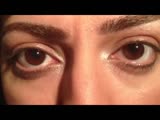 |
Downbeat Nystagmus Anti-GAD Cerebellar Syndrome | Raed Behbehani, MD | A patient with Anti-GAD positive Cerebellar syndrome with ataxia and opsoclonus due to downbeat nystagmus , treated with Baclofen with some improvement. | Downbeat Nystagmus |
| 461 |
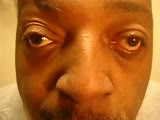 |
See-Saw Nystagmus | Raed Behbehani, MD | This nystagmus localizes to lesions supra/parasellar region (Large sellar and hypothalamic lesion) and is characterized by a see saw movement of elevation/intorsion of one eye and depression/extorsion of the other eye in a pendular fashion. This patient had a large pituitary macro-adenoma with supra... | See-Saw Nystagmus |
| 462 |
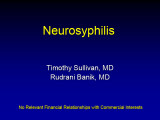 |
Neurosyphilis | Timothy Sullivan, MD; Rudrani Banik, MD | Power point of case of a 66 year old male with acute vision loss OD to no light perception. Underwent extensive work-up for cardiovascular and neurologic etiologies, all negative. Subsequent serologic work-up was positive for syphilis and the diagnosis of neurosyphilis was confirmed by lumbar punc... | Neurosyphilis; Infectious/Vasculitic Optic Neuropathy |
| 463 |
 |
The Ice Pack Test For Myasthenia | Ryan D. Walsh, MD; Collin McClelland, MD | The ice pack test is a simple, low-tech, bedside test that can readily be applied in the outpatient clinic or hospital setting, with minimal risk or discomfort. The ice pack test is used in patients with ptosis to help support or refute a diagnosis of myasthenia. We describe how to perform and int... | Ice Pack Test; Ice Test; Myasthenia Gravis; Ocular Myasthenia; Ptosis; Diagnostic Tests |
| 464 |
 |
Straatsma Syndrome | Charles A. McBride, OD | Triad of ipsilateral retinal nerve fiber myelination, myopia and amblyopia. Includes fundus photos and OCT showing normal macular architecture OD and thickened and hyper reflective RNFL outside macular region. | Straatsma Syndrome; Myelinated Nerve Fibers; myelination; anisometropia; amblyopia |
| 465 |
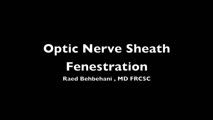 |
Optic Nerve Sheath Fenestration | Raed Behbehani, MD | Optic nerve sheath fenestration is performed to manage papilledema causing progressive loss of vision , due to raised intracranial pressure from Idiopathic Intracranial Hypertension or Cerebral Venous Sinus Thrombosis. The procedure is usually performed in cases of severe visual field loss or when m... | Optic Nerve Sheath Fenestration |
| 466 |
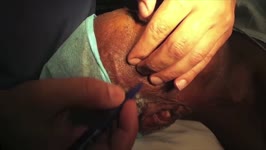 |
Temporal Artery Biopsy | Raed Behbehani, MD | This is a video of Superficial Temporal Artery Biopsy done under local anaesthesia for a patient who was suspected to have Giant Cell Arteritis (GCA. GCA is vasculitis of the medium sized vessels than can lead to permanent visual loss by causing Arteritis Ischemic Optic Neuropathy. The diagnosis of ... | Temporal Artery Biopsy; Giant Cell Arteritis |
| 467 |
 |
Pulsating Exophthalmos | Raed Behbehani, MD | This patient had brain surgery with bone removal resulted in transmission of CSF pulsation into the orbit and pulsating exophthalmos. This sign can also be seen in patient with neurofibromatosis with hypoplasia of the sphenoid wing bone. | Pulsating Exophthalmos; Neurofibromatosis |
| 468 |
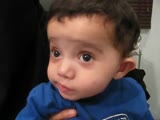 |
Congenital Oculomotor Apraxia | Raed Behbehani, MD | Congenital Ocular Motor Apraxia is an uncommon condition that causes children to have difficulty moving their eyes horizontally or from side to side. They are usually unable to quickly move their eyes from side to side and often have to turn their head (head jerking) and not just their eyes to track... | Oculomotor Apraxia |
| 469 |
 |
Ocular Neuromyotonia | Raed Behbehani, MD | Ocular Neuromytonia is a characterised by by paroxysmal tonic contraction of the extraocular muscles supplied by the oculomotor nerve. It is has been reported after cranial radiation therapy, especially to the sellar-parasellar region and from compressive lesions such tumours or aneurysms. The patho... | Ocular Neuromyotania |
| 470 |
 |
Periodic Alternating Nystagmus | Raed Behbehani, MD | PAN is a nystagamus characterized by a cycle of uniderectional jerk nystagamus for 60-90 sec , a pause for 10-20 sec and a a cycle of a jerk nystagmus in the opposite direction for 60-90 sec. It is found in brain stem and cerebellar conditions as well as ocular albinism ( as in this patient). | Periodic Alternating Nystagmus |
| 471 |
 |
See-Saw Nystagmus | Raed Behbehani, MD | See-saw nystagmus is a localizing nystagmus to lesions of the sellar and parasellar region. "It's characterized by synchronous elevation and intorsion of one eye and depression and extorsion of the contra lateral eye . This patent has a craniopharyngioma, which was operated twice, optic atrophy and ... | See-Saw Nystagmus |
| 472 |
 |
Marcus Gunn Jaw Winking | Raed Behbehani, MD | Marcus Gunn Jaw Wink causes congenital ptosis and eyelid retraction associated with jaw movement or sucking. It's due to "miswiring" between 3rd and 5th cranial nerves. The treatment of ptosis in children is surgery to prevent amblyopia . | Jaw Winking; Marcus Gunn |
| 473 |
 |
Apraxia of Eyelid Opening | Raed Behbehani, MD | Patient has Parkinson disease and has developed this condition following deep brain stimulation. | Apraxia; Eyelid Opening |
| 474 |
 |
Pertinent Pupillary Problems | Karl C. Golnik, MD | Pupil Exam is a narrated PowerPoint that covers the basic of examining pupils. | Pupil Exam; Pupil |
| 475 |
 |
Anisocoria | Karl C. Golnik, MD | This is a narrated PowerPoint presentation that covers the common causes of anisocoria. | Pupil; Anisocoria |
